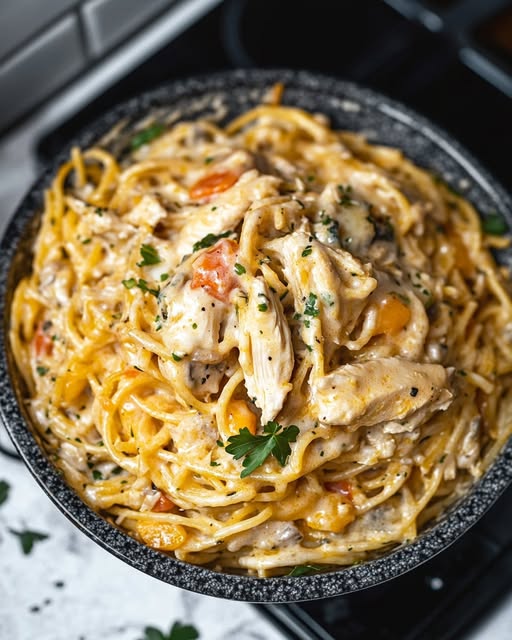Why Crispy Fried Shrimp Should Be Your Next Go-To Dish
There’s something magical about biting into perfectly fried shrimp. The crunch, the juicy pop of flavor, and that golden glow—it’s a party in your mouth! I first made these Crispy Fried Shrimp for a summer get-together, and let me tell you, they were gone faster than I could say “seconds, anyone?” Whether served as an appetizer or a main dish, this recipe is simple, delicious, and sure to impress. Plus, it’s ready in under 30 minutes. Who doesn’t love that?
A Little Background on Crispy Fried Shrimp
Fried shrimp has roots in coastal cuisines around the world. From Louisiana’s Cajun-spiced versions to Asian-inspired tempura shrimp, people have been frying these little sea treasures for centuries. My version blends classic Southern flavors with a touch of spice, thanks to paprika and cayenne pepper. It’s not too heavy, not too greasy—just perfectly balanced. When I tested this recipe, my family couldn’t stop raving about how crispy and flavorful they were. Trust me, once you try them, you’ll understand why!
Why You’ll Love This Recipe
This Crispy Fried Shrimp recipe is all about simplicity and bold flavors. The marinade tenderizes the shrimp while infusing them with tanginess from buttermilk. The seasoned flour coating adds a satisfying crunch without being overwhelming. And did I mention how quick it is? With minimal prep time and easy-to-find ingredients, this dish is perfect for busy weeknights or last-minute entertaining.
Perfect Occasions to Make Crispy Fried Shrimp
These shrimp are versatile! Serve them as an appetizer at game day parties, a centerpiece for seafood night, or even as finger food at holiday gatherings. They’re also great for picnics or beach days when paired with fresh lemon wedges and dipping sauces. Honestly, any occasion where good food brings people together is ideal for whipping up a batch of these golden beauties.
Ingredients You’ll Need
- 450 g (1 lb) large shrimp, peeled, deveined, and thawed if frozen
- 1 cup (245 g) buttermilk
- 1 cup (125 g) all-purpose flour
- 1 teaspoon paprika
- 1 teaspoon garlic powder
- ½ teaspoon onion powder
- ½ teaspoon kosher salt
- ½ teaspoon black pepper
- ¼ teaspoon cayenne pepper
- Vegetable oil, for frying
- Lemon wedges, for garnish
Substitution Options
If you don’t have buttermilk, mix 1 cup of milk with 1 tablespoon of vinegar or lemon juice and let it sit for 5 minutes. For gluten-free diets, swap the all-purpose flour for rice flour or a gluten-free blend. Instead of vegetable oil, you can use peanut oil or canola oil. If you want milder heat, skip the cayenne altogether.
Step 1: Marinate the Shrimp
Start by placing your shrimp in a medium bowl. Pour the buttermilk over them, ensuring each one is fully coated. Let them soak for at least 15 minutes at room temperature. This step is key because the buttermilk tenderizes the shrimp and gives them extra juiciness. Pro tip: Don’t rush the marinade; patience pays off here!
Step 2: Prepare the Seasoned Flour
In another bowl, whisk together the flour, paprika, garlic powder, onion powder, salt, black pepper, and cayenne. This mixture will create a flavorful crust that seals in the shrimp’s natural sweetness. Take a moment to inhale the aroma—it’s like a preview of the deliciousness to come!
Step 3: Coat the Shrimp
Remove each shrimp from the buttermilk, letting the excess drip off, then dredge it generously in the seasoned flour. Make sure every inch is covered for maximum crunch. Lay the coated shrimp on a baking sheet while you heat the oil. Chef’s tip: Shake off any extra flour before frying to prevent burning.
Step 4: Heat the Oil
Pour about 5 cm (2 inches) of vegetable oil into a large pot and heat it to 180°C (350°F). Use a thermometer to monitor the temperature. Hot oil ensures your shrimp cook quickly and stay juicy inside. Pro tip: Keep the flame steady to maintain consistent heat.
Step 5: Fry the Shrimp
Carefully lower the shrimp into the hot oil in small batches. Overcrowding will drop the oil’s temperature, leading to soggy results. Fry for 2-3 minutes until golden brown and crispy. Watch closely—they cook fast! Once done, transfer them to a plate lined with paper towels to drain.
Step 6: Garnish and Serve
Sprinkle the fried shrimp with a squeeze of fresh lemon juice for brightness. Arrange them on a platter with lemon wedges and your favorite dipping sauce. I recommend tartar sauce or spicy aioli. Serve immediately while they’re still warm and crunchy.
Timing Breakdown
- Prep Time: 10 minutes
- Cooking Time: 3 minutes per batch
- Marinating Time: 15 minutes
- Total Time: Approximately 28 minutes
Chef’s Secret
To ensure ultra-crispy shrimp, double-coat them. After the first dredge in flour, dip them back into the buttermilk, then coat them again in the seasoned flour. This extra layer locks in moisture and boosts crunchiness.
An Interesting Tidbit About Shrimp
Did you know shrimp are the most widely consumed seafood in the U.S.? Their popularity stems from their mild flavor and versatility. Whether grilled, boiled, or fried, they adapt beautifully to countless recipes.
Necessary Equipment
- Large pot for frying
- Thermometer for monitoring oil temperature
- Tongs or slotted spoon for handling shrimp
- Baking sheet for resting coated shrimp
- Paper towels for draining excess oil
Storage Tips
Leftover Crispy Fried Shrimp can be stored in an airtight container in the fridge for up to two days. However, keep in mind that reheating may soften the crust. To reheat, place them on a baking sheet and bake at 180°C (350°F) for 5-7 minutes.
Avoid freezing cooked shrimp, as the texture becomes mushy upon thawing. If you need to prep ahead, freeze raw shrimp after coating them in flour. Fry directly from frozen, adding a minute or two to the cooking time.
For optimal freshness, store sauces separately in small jars or containers. This way, everything tastes fresh when you’re ready to serve.
Tips and Advice
- Use large or jumbo shrimp for better texture and easier handling.
- Pat the shrimp dry before marinating to help the buttermilk adhere better.
- Keep a clean workspace to make breading easier and less messy.
- Test one shrimp first to check seasoning and frying time.
Presentation Ideas
- Serve on a wooden board with lemons and herbs for a rustic look.
- Arrange in a cone-shaped paper holder for a fun street-food vibe.
- Garnish with chopped parsley or chives for a pop of color.
Healthier Alternatives
- Oven-Baked Shrimp: Toss shrimp in olive oil and breadcrumbs, then bake at 200°C (400°F) for 10-12 minutes.
- Air-Fried Shrimp: Lightly spray breaded shrimp with cooking spray and air-fry at 180°C (350°F) for 8-10 minutes.
- Grilled Shrimp: Skewer shrimp and grill over medium heat for 2-3 minutes per side.
- Coconut-Crusted Shrimp: Replace some flour with shredded coconut for a tropical twist.
- Zucchini-Crumb Shrimp: Add grated zucchini to the breading for added nutrition.
- Spice-Rubbed Shrimp: Skip the breading and toss shrimp in a dry spice rub before pan-searing.
Mistake 1: Overcrowding the Pan
Frying too many shrimp at once lowers the oil’s temperature, resulting in greasy, unevenly cooked bites. Always fry in small batches. Pro tip: Work in stages and keep cooked shrimp warm in a low oven while finishing the rest.
Mistake 2: Skipping the Thermometer
Without a thermometer, you risk burning the shrimp or leaving them undercooked. Invest in a reliable kitchen thermometer to ensure precise oil temperature.
Mistake 3: Not Drying the Shrimp
Wet shrimp cause splattering and prevent proper browning. Pat them dry with paper towels before marinating for best results.
FAQ
Can I use frozen shrimp?
Yes, just thaw them completely and pat them dry before using. Frozen shrimp work wonderfully in this recipe.
What’s the best oil for frying?
Vegetable, canola, or peanut oil works well due to their high smoke points. Avoid butter or olive oil, which burn easily at high temperatures.
How do I know when the shrimp are done?
Shrimp turn pink and opaque when cooked. They should feel firm but still slightly springy to the touch.
Can I prep this ahead of time?
Absolutely! Coat the shrimp in flour and refrigerate them for up to 2 hours before frying. Just bring them to room temperature before cooking.
What sauces pair well with these shrimp?
Try tartar sauce, cocktail sauce, sriracha mayo, or a simple squeeze of fresh lemon. Each option complements the dish beautifully.
Is there a dairy-free alternative to buttermilk?
Yes, mix almond milk or soy milk with a splash of vinegar or lemon juice for a plant-based version.
Can I use smaller shrimp?
While larger shrimp are preferred, smaller ones work too. Adjust the frying time slightly to avoid overcooking.
Why does my breading fall off?
Make sure the shrimp are properly dried and evenly coated. Shaking off excess flour helps the breading stick better.
How can I make this spicier?
Increase the amount of cayenne pepper or add red pepper flakes to the flour mixture for extra kick.
What sides go well with fried shrimp?
Serve with coleslaw, fries, corn on the cob, or a fresh salad. These pairings balance the richness of the shrimp perfectly.
Final Thoughts
Crispy Fried Shrimp is more than just a dish—it’s a celebration of flavor, texture, and joy. Whether you’re hosting friends or treating yourself, this recipe delivers big taste with minimal effort. So grab some shrimp, roll up your sleeves, and get frying. Your taste buds will thank you!

Crispy Fried Shrimp
Ingredients
Equipment
Method
- Place shrimp in a medium bowl and pour buttermilk over them, ensuring they are fully coated. Let marinate for at least 15 minutes.
- In another bowl, whisk together flour, paprika, garlic powder, onion powder, salt, black pepper, and cayenne.
- Remove shrimp from buttermilk, letting excess drip off, and dredge generously in the seasoned flour. Lay coated shrimp on a baking sheet.
- Pour about 5 cm (2 inches) of vegetable oil into a large pot and heat to 180°C (350°F), monitoring with a thermometer.
- Lower shrimp in small batches into the hot oil and fry for 2-3 minutes until golden brown and crispy. Transfer to a plate lined with paper towels to drain.
- Garnish fried shrimp with a squeeze of lemon juice and serve with lemon wedges and dipping sauce.
